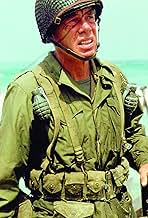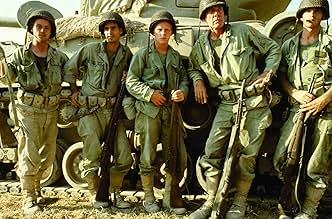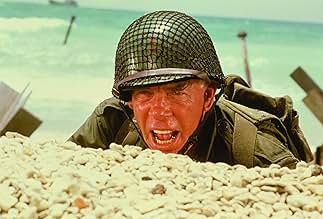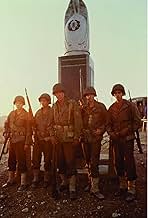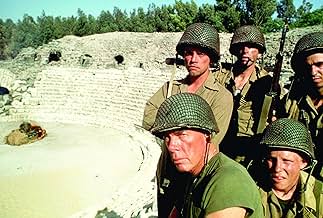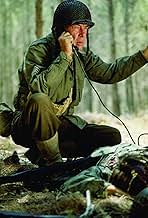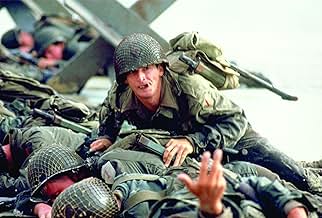NOTE IMDb
7,1/10
22 k
MA NOTE
Un sergent endurci et les quatre membres principaux de son unité d'infanterie tentent de survivre à la seconde guerre mondiale alors qu'ils se déplacent de bataille en bataille dans toute l'... Tout lireUn sergent endurci et les quatre membres principaux de son unité d'infanterie tentent de survivre à la seconde guerre mondiale alors qu'ils se déplacent de bataille en bataille dans toute l'Europe.Un sergent endurci et les quatre membres principaux de son unité d'infanterie tentent de survivre à la seconde guerre mondiale alors qu'ils se déplacent de bataille en bataille dans toute l'Europe.
- Récompenses
- 2 victoires et 2 nominations au total
Stéphane Audran
- Underground Walloon Fighter at Asylum
- (as Stephane Audran)
Avis à la une
"The Big Red One" is an episodic war movie from maverick American filmmaker Samuel Fuller. Having only seen "Shock Corridor" from the director's oeuvre, I didn't know what to expect from him this time around. It becomes obvious pretty quickly that Fuller was never going to be a mainstream filmmaker. There's something about his style that's really off-putting. You empathise with the camera, not the actors. It's like they're at odds with each other.
This is not a bad thing, as you can tell from the enthusiastic reception Fuller's movies have gotten here on IMDB. But "The Big Red One" is also drastically cut down from the original print Fuller had, and I wonder if that's why it feels so disjointed.
Of course, it is supposed to be episodic, but I don't know. I didn't really get into it.
This is not a bad thing, as you can tell from the enthusiastic reception Fuller's movies have gotten here on IMDB. But "The Big Red One" is also drastically cut down from the original print Fuller had, and I wonder if that's why it feels so disjointed.
Of course, it is supposed to be episodic, but I don't know. I didn't really get into it.
This review is on the "reconstructed" DVD, a version that came out several years ago, adding 49 minutes to the original 1980 movie. (The film runs 162 minutes, not 158 as stated on the IMDb title page.)
The "old" version was very good, and this newer version makes the film even better. Either way, you have a solid war movie.
For men - and that's who will primarily watch this movie because it's a guy's flick with no romance and no women leads - this keeps the action coming, but without overdoing it. You can different kinds of action scenes, too, not just people shooting at one another.
I also appreciated the photography. It's a good visual movie. The added footage looked sharper and clearer than the previously shown, but either way it was nicely filmed and directed. Of course, the director is the famous Sam Fuller, who did a number of tough film noirs, among other things.
Speaking of tough, the person who makes this movie a notch above average is Lee Marvin. He is just excellent as the tough-on-the-outside-but-soft-hearted underneath commanding officer, known only as "The Sergeant." With his deep voice and weathered face, Marvin makes for an effective leader of tough guys. The language was much milder in here than you find in more modern films, although it can be crude in a few spots. There are no f-words and about seven usages of the Lord's name in vain. However, there are a number of sexual references, some crude but, hey, that's "guy talk." All the young soldiers were good, too. It was especially interesting to see baby-faced Star Wars' star, Mark Hamill, playing one of the soldiers in the unit called "The Big Red One."
The story with narration by one of the soldiers, tells of Marvin and his handful of men who travel and do battle from North Africa to Sicily, then Italy, the beaches of Normandy on D- Day and into Germany in addition to a few other memorable stops such as "an insane asylum."
It's long, but I never found it boring and the men never stay too long in one spot.
The "old" version was very good, and this newer version makes the film even better. Either way, you have a solid war movie.
For men - and that's who will primarily watch this movie because it's a guy's flick with no romance and no women leads - this keeps the action coming, but without overdoing it. You can different kinds of action scenes, too, not just people shooting at one another.
I also appreciated the photography. It's a good visual movie. The added footage looked sharper and clearer than the previously shown, but either way it was nicely filmed and directed. Of course, the director is the famous Sam Fuller, who did a number of tough film noirs, among other things.
Speaking of tough, the person who makes this movie a notch above average is Lee Marvin. He is just excellent as the tough-on-the-outside-but-soft-hearted underneath commanding officer, known only as "The Sergeant." With his deep voice and weathered face, Marvin makes for an effective leader of tough guys. The language was much milder in here than you find in more modern films, although it can be crude in a few spots. There are no f-words and about seven usages of the Lord's name in vain. However, there are a number of sexual references, some crude but, hey, that's "guy talk." All the young soldiers were good, too. It was especially interesting to see baby-faced Star Wars' star, Mark Hamill, playing one of the soldiers in the unit called "The Big Red One."
The story with narration by one of the soldiers, tells of Marvin and his handful of men who travel and do battle from North Africa to Sicily, then Italy, the beaches of Normandy on D- Day and into Germany in addition to a few other memorable stops such as "an insane asylum."
It's long, but I never found it boring and the men never stay too long in one spot.
This film is really about the experiences that Sam Fuller had during WWII. It is a bit dated, and the low budget really shows, but SF clearly did the best with what he had, and it stands as a great monument on war from a director who was really there.
All of the characters are very likeable, and well acted by Lee Marvin, Mark Hamill, Robert Carradine, and company. The movie is fiction but influenced by real events. Many of the scenes, especially one involving a group of older sicilian women who cook a big meal for the squad, ring very true, since a fiction writer would obviously try and spice them up--the film is very honest, and it is good that Fuller left this story for us. I also like how it ends on a positive, optimistic note.
"The real glory of war is surviving."
All of the characters are very likeable, and well acted by Lee Marvin, Mark Hamill, Robert Carradine, and company. The movie is fiction but influenced by real events. Many of the scenes, especially one involving a group of older sicilian women who cook a big meal for the squad, ring very true, since a fiction writer would obviously try and spice them up--the film is very honest, and it is good that Fuller left this story for us. I also like how it ends on a positive, optimistic note.
"The real glory of war is surviving."
A lot of people hate The Big Red One. They call it farcical, uneven, clichéd. They find it farcical, I believe, because the film revels in the absurdity of war rather than gloss over it. They would rather watch a film, like Saving Private Ryan, which ignores absurdity in favor of violence. These people find it uneven because the "important scenes" (like the D-Day and North African invasion) take only a minute or two to conclude, while other scenes, less typical of a war movie, spread out before us. They call it clichéd because the movie is unsubtle in its treatment of character development and plot.
I cannot agree with these beliefs. The Big Red One is not only one of the greatest WWII films, it is also one of the greatest war movies.
Sam Fuller's film, which was butchered by the studio, is the picaresque tale of 5 members of the First Infantry, known, because of their shoulder patch, as the Big Red One. The film moves from one story to the next without spending too much time on any particular tale.
The individual vignettes, as they must, vary in quality, but on the whole are excellent. The Big Red One stirs within you a desire to run right out and tell your friends about this amazing scene or that.
There's the soldier who loses his testicle, the birthing scene in the belly of a tank, Lee Marvin, in Middle Eastern garb, traipsing across a beach, soldiers dug into holes over which a Panzer tank division travels, the entire Mad House segment... The list goes on.
Some people dislike the absurdest nature of several of this film's stories, but, for me, those surreal touches make this film great.
Without them (and there are a lot), you would be left with a very normal and very boring film. Using bandoleers as stirrups is genius, as is the woman faking crazy as she whirls through a monastery, slicing German throats.
The performances are solid, for this type of film, but if you are looking for subtlety, go elsewhere. Each character is drawn in broad strokes; you never learn too much about them, but you learn enough to understand who they are and why. Lee Marvin, as usual, is amazing. He is one of the great, gruff actors of our time, bringing a special, intangible quality to every film in which I've seen him. He makes every movie he's in better just by showing up. There are too few actors about whom you can say that.
Like the acting, the direction is masculine, but, for a war movie, that's a compliment. In some ways, Fuller's direction here and in his other films reminds me of Hemmingway's writing - terse and effective. Both men believe in an economy of shots or words, depending on their medium, but, through that economy, they attain a muscular sort of poetry akin to the beauty of a horse's rippling muscles as it races on a plain. Fuller's direction here, though not his best when compared to Underworld USA or Shock Corridor, is still better than most, especially considering that this was his first film in several years.
All in all, I find the Big Red One to be an exemplary war movie, even in its emasculated format (I cannot wait to see the restored, 140 minute print, which should improve upon scenes that feel to brief in this version). It's certainly no Apocalypse Now, but it puts to shame most World War II epics before or since.
I cannot agree with these beliefs. The Big Red One is not only one of the greatest WWII films, it is also one of the greatest war movies.
Sam Fuller's film, which was butchered by the studio, is the picaresque tale of 5 members of the First Infantry, known, because of their shoulder patch, as the Big Red One. The film moves from one story to the next without spending too much time on any particular tale.
The individual vignettes, as they must, vary in quality, but on the whole are excellent. The Big Red One stirs within you a desire to run right out and tell your friends about this amazing scene or that.
There's the soldier who loses his testicle, the birthing scene in the belly of a tank, Lee Marvin, in Middle Eastern garb, traipsing across a beach, soldiers dug into holes over which a Panzer tank division travels, the entire Mad House segment... The list goes on.
Some people dislike the absurdest nature of several of this film's stories, but, for me, those surreal touches make this film great.
Without them (and there are a lot), you would be left with a very normal and very boring film. Using bandoleers as stirrups is genius, as is the woman faking crazy as she whirls through a monastery, slicing German throats.
The performances are solid, for this type of film, but if you are looking for subtlety, go elsewhere. Each character is drawn in broad strokes; you never learn too much about them, but you learn enough to understand who they are and why. Lee Marvin, as usual, is amazing. He is one of the great, gruff actors of our time, bringing a special, intangible quality to every film in which I've seen him. He makes every movie he's in better just by showing up. There are too few actors about whom you can say that.
Like the acting, the direction is masculine, but, for a war movie, that's a compliment. In some ways, Fuller's direction here and in his other films reminds me of Hemmingway's writing - terse and effective. Both men believe in an economy of shots or words, depending on their medium, but, through that economy, they attain a muscular sort of poetry akin to the beauty of a horse's rippling muscles as it races on a plain. Fuller's direction here, though not his best when compared to Underworld USA or Shock Corridor, is still better than most, especially considering that this was his first film in several years.
All in all, I find the Big Red One to be an exemplary war movie, even in its emasculated format (I cannot wait to see the restored, 140 minute print, which should improve upon scenes that feel to brief in this version). It's certainly no Apocalypse Now, but it puts to shame most World War II epics before or since.
Some movies are like buried treasure; someone manages to slip them into the theater, practically under every critic's nose, where they either thrive or famish and then vanish into the nearest video catalog. "The Big Red One" is one of those films. For all the hoopla created by "Saving Private Ryan" (another excellent film, which, in my opinion, had a better understanding of it's subject than a lot of it's critics gave it credit for), it owed a great deal to what Sam Fuller did a decade and a half before.
Lee Marvin, an actual WWII veteran himself, holds the film together as the tough but exhausted seargent. When he tells Mark Hamill (yes, Luke Skywalker, folks) that you don't murder animals, you kill them, the look on his face after that seems to say that he wished it could be some other way. It's hard to grab defining moments in this film as stand-out, but the two sequences that stick the most to my mind are the taking of the insane asylum and the horrors of the concentration camp. While other movies have focused on specific campaigns, "The Big Red One" deserves high marks for painting the broad canvass of the Second World War from the perspective of the guys who actually had to do the work.
Lee Marvin, an actual WWII veteran himself, holds the film together as the tough but exhausted seargent. When he tells Mark Hamill (yes, Luke Skywalker, folks) that you don't murder animals, you kill them, the look on his face after that seems to say that he wished it could be some other way. It's hard to grab defining moments in this film as stand-out, but the two sequences that stick the most to my mind are the taking of the insane asylum and the horrors of the concentration camp. While other movies have focused on specific campaigns, "The Big Red One" deserves high marks for painting the broad canvass of the Second World War from the perspective of the guys who actually had to do the work.
Le saviez-vous
- AnecdotesThe bulk of the picture was shot in Israel, and director Samuel Fuller remarked that it was unsettling after a scene was shot when the German soldiers and SS troops would take off their helmets and Fuller would see them wearing yarmulkes; also, between takes they would be sitting around the set in full Nazi uniform speaking Hebrew or reading the Torah.
- GaffesDuring the WW1 scene between the Sergeant and the officer in the dug-out, the Sergeant learns that the armistice had been signed 4 hours previously at 1100hrs, November 11, 1918. While talking with the officer, the sergeant is cutting a piece of red cloth in the shape of a number '1' which he says he will submit as a proposed insignia for the division. However the shoulder sleeve insignia for the 1st Division consisting of a red number "1" was already approved on 31 Oct 1918.
- Citations
Johnson: [concerning a woman in labor] How do you say "push" in French?
The Sergeant: Poussez.
Johnson: [to woman] Pussy! Pussy! Pussy!
- Versions alternativesIn 2004, film critic Richard Schickel restored this film to a new director's cut length of approximately 160 minutes. Using Samuel Fuller's production notes and the full-length, unexpurgated script, Schickel restored the footage that was forced to be cut by the studio upon its original 1980 release (which runs 116 minutes). The restored version's DVD release date is 3 May 2005. This longer, epic-length version is closer to Fuller's original vision for the film.
- ConnexionsFeatured in A tout coeur: Épisode datant du 7 mai 1984 (1984)
- Bandes originalesHorst-Wessel-Lied
Written by Horst Wessel
Meilleurs choix
Connectez-vous pour évaluer et suivre la liste de favoris afin de recevoir des recommandations personnalisées
Détails
- Date de sortie
- Pays d’origine
- Langues
- Aussi connu sous le nom de
- The Big Red One
- Lieux de tournage
- Sociétés de production
- Voir plus de crédits d'entreprise sur IMDbPro
Box-office
- Budget
- 4 500 000 $US (estimé)
- Montant brut aux États-Unis et au Canada
- 7 206 220 $US
- Montant brut mondial
- 7 206 823 $US
- Durée
- 1h 53min(113 min)
- Couleur
- Mixage
- Dolby Stereo(original release)
- Rapport de forme
- 1.85 : 1
Contribuer à cette page
Suggérer une modification ou ajouter du contenu manquant


